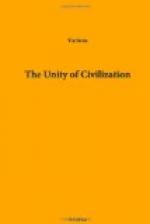Two contemporary lines of discovery have tended to determine the result. Geology gives us a very long margin of time since the north-west quadrant began to be reinhabited by human beings after the Ice Age, and assumed approximately its present distribution of land and water. Archaeology, which in this aspect is the special stratigraphy of man, sanctions an extension of time, since not merely human beings but organized societies of men made their appearance in Europe, which far exceeds the period required, or commonly assumed, for the spread of any known Indo-European language, from any possible ‘home’ to any region where it was spoken at the beginning of historic time. And not only does archaeological evidence enable us to detect such societies sedentary for a while on this or that site over the face of Europe and its neighbourhood; it traces not merely one ‘prehistoric culture’, but a number of distinct types of such culture, each with its own geographical distribution, and with distributions which expand and contract at different times, superseding one type of culture here, and another there, and in turn superseded by others.
It is not easy to bring home the extent of this diversity to those who are not familiar with the physical condition of a Europe which was as yet largely in the ‘backwood’ stage of exploitation. But it will give some idea of the range of contrast, if we revert to the method of Thucydides,[7] and compare the unexploited Europe of the days before agriculture, with unexploited America at the time of its discovery by Europeans. Here, within the same geographical limits of the north temperate zone, and with the far simpler scheme of surface relief which characterizes the New World, we have civilizations as different as those of the Eskimo, the Algonkin peoples of the coniferous forests, the Huron and Iroquois of the deciduous hardwoods, horticultural Muscogeans in the south-east, buffalo-hunting Sioux on the prairie, predatory Apaches and Blackfeet in the foothills, and littoral and riparian fisher-folk on the Pacific slope: just as recognizable now, in their distributions and overlaps, by the fashions of their pipe-bowls and other debris, as are the representatives of the ‘row-grave’ culture or the makers of ‘band-keramik’ in Central Europe.
Keeping in mind this analogy of prehistoric Europe with pre-Columbian North America, let us classify the problems of subsistence which these Old World regions offered to prehistoric man; and consider, granting him all the reason in the world, and uniform physique (if you please) as well, how he is to formulate solutions which shall show any trace of uniformity, and yet be solutions for him of the one Protean problem, how to sustain life here and now?




